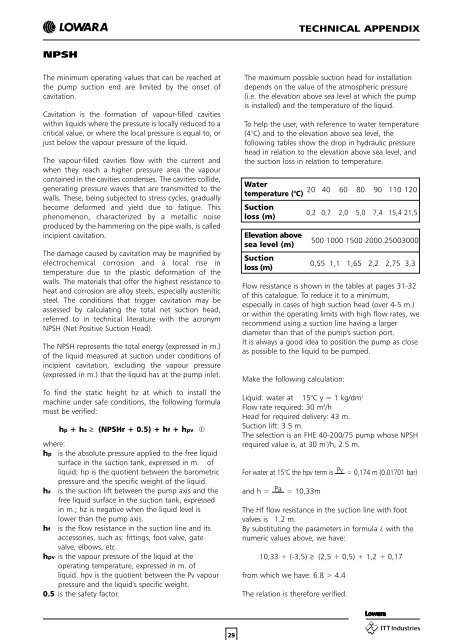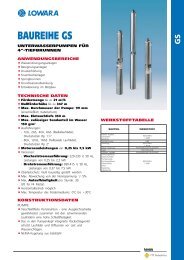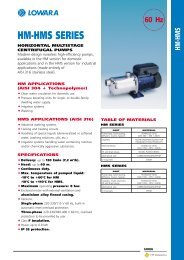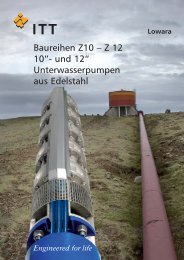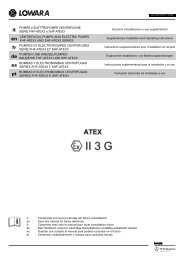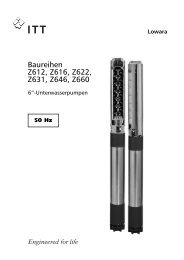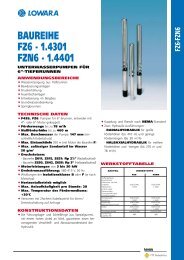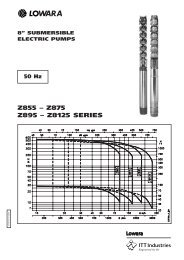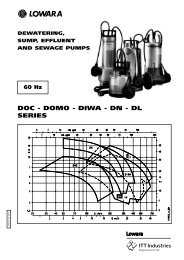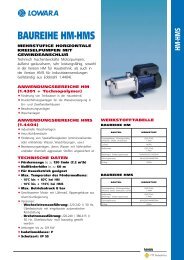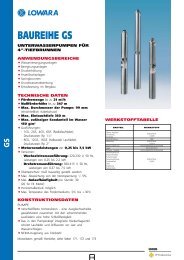CEA-CA SERIES
CEA-CA SERIES
CEA-CA SERIES
You also want an ePaper? Increase the reach of your titles
YUMPU automatically turns print PDFs into web optimized ePapers that Google loves.
TECHNI<strong>CA</strong>L APPENDIX<br />
NPSH<br />
The minimum operating values that can be reached at<br />
the pump suction end are limited by the onset of<br />
cavitation.<br />
Cavitation is the formation of vapour-filled cavities<br />
within liquids where the pressure is locally reduced to a<br />
critical value, or where the local pressure is equal to, or<br />
just below the vapour pressure of the liquid.<br />
The vapour-filled cavities flow with the current and<br />
when they reach a higher pressure area the vapour<br />
contained in the cavities condenses. The cavities collide,<br />
generating pressure waves that are transmitted to the<br />
walls. These, being subjected to stress cycles, gradually<br />
become deformed and yield due to fatigue. This<br />
phenomenon, characterized by a metallic noise<br />
produced by the hammering on the pipe walls, is called<br />
incipient cavitation.<br />
The damage caused by cavitation may be magnified by<br />
electrochemical corrosion and a local rise in<br />
temperature due to the plastic deformation of the<br />
walls. The materials that offer the highest resistance to<br />
heat and corrosion are alloy steels, especially austenitic<br />
steel. The conditions that trigger cavitation may be<br />
assessed by calculating the total net suction head,<br />
referred to in technical literature with the acronym<br />
NPSH (Net Positive Suction Head).<br />
The NPSH represents the total energy (expressed in m.)<br />
of the liquid measured at suction under conditions of<br />
incipient cavitation, excluding the vapour pressure<br />
(expressed in m.) that the liquid has at the pump inlet.<br />
To find the static height hz at which to install the<br />
machine under safe conditions, the following formula<br />
must be verified:<br />
hp + hz ≥ (NPSHr + 0.5) + hf + hpv ➀<br />
where:<br />
hp is the absolute pressure applied to the free liquid<br />
surface in the suction tank, expressed in m. of<br />
liquid; hp is the quotient between the barometric<br />
pressure and the specific weight of the liquid.<br />
hz is the suction lift between the pump axis and the<br />
free liquid surface in the suction tank, expressed<br />
in m.; hz is negative when the liquid level is<br />
lower than the pump axis.<br />
hf is the flow resistance in the suction line and its<br />
accessories, such as: fittings, foot valve, gate<br />
valve, elbows, etc.<br />
hpv is the vapour pressure of the liquid at the<br />
operating temperature, expressed in m. of<br />
liquid. hpv is the quotient between the Pv vapour<br />
pressure and the liquid's specific weight.<br />
0.5 is the safety factor.<br />
The maximum possible suction head for installation<br />
depends on the value of the atmospheric pressure<br />
(i.e. the elevation above sea level at which the pump<br />
is installed) and the temperature of the liquid.<br />
To help the user, with reference to water temperature<br />
(4°C) and to the elevation above sea level, the<br />
following tables show the drop in hydraulic pressure<br />
head in relation to the elevation above sea level, and<br />
the suction loss in relation to temperature.<br />
Water<br />
20 40 60 80 90 110 120<br />
temperature (°C)<br />
Suction<br />
loss (m)<br />
Elevation above<br />
sea level (m)<br />
Suction<br />
loss (m)<br />
0,2 0,7 2,0 5,0 7,4 15,4 21,5<br />
500 1000 1500 2000 25003000<br />
0,55 1,1 1,65 2,2 2,75 3,3<br />
Flow resistance is shown in the tables at pages 31-32<br />
of this catalogue. To reduce it to a minimum,<br />
especially in cases of high suction head (over 4-5 m.)<br />
or within the operating limits with high flow rates, we<br />
recommend using a suction line having a larger<br />
diameter than that of the pump's suction port.<br />
It is always a good idea to position the pump as close<br />
as possible to the liquid to be pumped.<br />
Make the following calculation:<br />
Liquid: water at 15°C y = 1 kg/dm 3<br />
Flow rate required: 30 m 3 /h<br />
Head for required delivery: 43 m.<br />
Suction lift: 3.5 m.<br />
The selection is an FHE 40-200/75 pump whose NPSH<br />
required value is, at 30 m 3 /h, 2.5 m.<br />
For water at 15°C the hpv term is Pv = 0,174 m (0.01701 bar)<br />
<br />
and h = Pa = 10,33m<br />
<br />
The Hf flow resistance in the suction line with foot<br />
valves is 1.2 m.<br />
By substituting the parameters in formula ¿ with the<br />
numeric values above, we have:<br />
10,33 + (-3,5) ≥ (2,5 + 0,5) + 1,2 + 0,17<br />
from which we have: 6.8 > 4.4<br />
The relation is therefore verified.<br />
29


